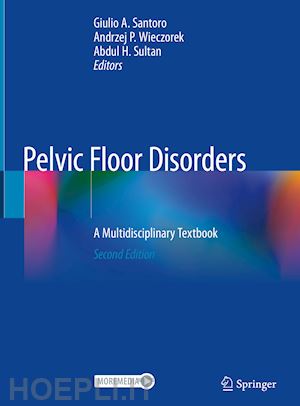

Questo prodotto usufruisce delle SPEDIZIONI GRATIS
selezionando l'opzione Corriere Veloce in fase di ordine.
Pagabile anche con Carta della cultura giovani e del merito, 18App Bonus Cultura e Carta del Docente
Section I - Pelvic Floor Anatomy and Physiology: 1. State of the Art Pelvic Floor Anatomy - 2. Biochemical Properties and Hormonal Receptors of Pelvic Floor Tissues.- 3. The Integral Theory: A Musculo-elastic Theory of Pelvic Floor Function and Dysfunction.- 4. The Pelvic Floor: Functional Concepts and Neurocontrol.- Section II - Pelvic Floor Imaging: 5. Principles and Technical Aspects of Integrated Pelvic Floor Ultrasound.- 6. Transperineal Ultrasonography: Methodology and Normal Pelvic Floor Anatomy.- 7. Endovaginal Ultrasonography: Methodology and Normal Pelvic Floor Anatomy.- 8. Endoanal and Endorectal Ultrasonography: Methodology and Normal Pelvic Floor Anatomy.-9. Technical Innovations in Pelvic Floor Ultrasonography - 10. X-ray Techniques: Methodology and Normal Pelvic Floor Anatomy.- 11. Magnetic Resonance Imaging: Methodology and Normal Pelvic Floor Anatomy.- 12. Dynamic Magnetic Resonance of the Pelvic Floor: Technique and Methodology. Section III -Obstetric PelvicFloor and Anal Sphincter Trauma: 13. Mechanisms of Pelvic Floor Trauma During Vaginal Delivery.- 14. Obstetric Perineal and Anal Sphincter Trauma.-15. Neurogenic Trauma During Vaginal Delivery.- 16. Prevention of Perineal Trauma. Section IV -Urinary Incontinence and Voiding Dysfunction: 17. Overview: Epidemiology and Etiology of Urinary Incontinence and Voiding Dysfunction. Assessment: 18. Patient-Reported Outcome Assessment.- 19. Urodynamics Techniques and Clinical Application.- 20. Ultrasonographic Techniques and Clinical Application. Management: 21. Behavioural Therapies and Biofeedback.- 22. Selection of Midurethral Slings for Women with Stress Urinary Incontinence.- 23. Tape Positioning- Does it matter?.- 24. Colposuspension and Fascial Slings.- 25. Injectable Biomaterials.- 26. Artificial Urinary Sphincter in Women.- 27. Pharmacological Treatment of Urinary Incontinence, Overactive Bladder and Voiding Dysfunction.- 28. Intravesical Botulinum toxin for treatment of Overactive Bladder 29. Sacral Nerve Stimulation for overactive bladder and voiding dysfunction. Section V - Anal Incontinence: 30. Overview: Epidemiology and Etiology of Anal Incontinence.- Assessment: 31. Patient-Reported Outcome Assessment.- 32. Anorectal Manometry: Techniques and Clinical Application.- 33. Three-dimensional Endoanal Ultrasonography.- 34. Transperineal Ultrasonography.- 35. Magnetic Resonance Imaging.- 36. Neurophysiological Evaluation: Techniques and Clinical Application. Management: 37. Treatment: Which Outcome Should We Measure?.- 38. Behavioural therapies and biofeedback.- 39. Pharmacological Treatment of Anal Incontinence: the Evidence.- 40. Sphincter Repair and Postanal Repair.- 41. Dynamic Graciloplasty.- 42. Injectable Biomaterials .- 43. Artificial Bowel Sphincter and Magnetic Anal Sphincter.- 44. Sacral Nerve Stimulation.- 45. Posterior Tibial Nerve Stimulation.- 46. Radiofrequency.- 47. Other Surgical Options for Anal Incontinence: From End Stoma to Stem Cell. Section VI - Pelvic Organ Prolapse: 48. Overview: Epidemiology and Etiology of Pelvic Organ Prolapse - Assessment: 49. Patient-Reported Outcome and Clinical Assessment .- 50. Integrated Imaging Approach to Pelvic Organ Prolapse.- 51. Transperineal Ultrasonography for Pelvic Organ Prolapse and Levator ani Damage.- 52. Three-dimensional and Dynamic Endovaginal Ultrasonography for Pelvic Organ Prolapse and Levator ani Damage.-53. Magnetic Resonance and Levator Ani Damage.- 54. Dynamic Magnetic Resonance Imaging for Pelvic Organ Prolapse. Management: 55. Pelvic Floor Muscle Training in Prevention and Treatment of Pelvic Organ Prolapse.- 56. Use of Pessaries for Pelvic Organ Prolapse.- 57. Anterior and posterior colporrhaphy – native tissue versus mesh.- 58. The Abdominal versus Vaginal approach to middle compartment prolapse.- 59. The Laparoscopic Approach to Urogenital Prolapse - 60. The Robotic Approach to Urogenital Prolapse.- 61. Concurrent continence and prolapse surgery - 62. Multidisciplinary Approach for pelvic organ prolapse – the way forward?.-Section VII - Constipation and Obstructed Defecation: 63. Epidemiology, Phatophysiology, Evaluation and Management of Constipation and Obstructed Defecation. An Overview. Assessment: 64. Patient-Reported Outcome and Clinical Assessment.- 65. Anorectal Manometry, Rectal Sensory Testing and Evacuation Tests.-66. Transperineal Ultrasonography and Obstructed Defecation.-67. Echodefecography: Technique and Clinical Application.- 68 Evacuation Proctography.- Management: 69. Pharmacological Treatment of Irritable Bowel Syndrome and Constipation: the Evidence .- 70. The Abdominal Approach to Rectal Prolapse.- 71. The Perineal Approach to Rectal Prolapse.- 72. The Laparoscopic Approach to Posterior Compartment Prolapse.- 73. The Robotic Approach to Rectal Prolapse.-74. Sacral Nerve Stimulation in Constipation.- Section VIII - Pelvic Pain and Sexual Dysfunction.-75. Painful Bladder Syndrome.- 76. Pelvic Pain Associated with a Gynecologic Etiology.-77. Pelvic Pain Associated with a Coloproctologic Etiology.- 78 Female sexual dysfunction.- 79. Surface Electromyography and Myofascial Therapy.-80. Pharmacological Treatment of Chronic Pelvic Pain.-Section IX – Fistula: 81. Urogenital Fistulae.- 82. Rectovaginal Fistulae.- 83. Emerging Concepts in Classification of Anorectal Fistulae.- 84. Ultrasonographic Assessment of Anorectal Fistulae.- 85. MRI Assessment of Anorectal Fistulae.- 86. Surgical Treatment of Anorectal Fistulae.- 87. Management of Anorectal Fistulae in Crohn’s Disease.- Section X - Failure or Recurrence after Surgical Treatment: What to Do When it All Goes Wrong: 88. Imaging of Complications After Urogynecologic Surgery.- 89. Surgical Management of Complications After Urogynecologic Surgery.- 90. Imaging of Complications After Colorectal Surgery.- 91. Surgical Management of Complications after Colorectal Surgery. Section XI – Miscellaneous: 92. Congenital Abnormalities of the Pelvic Floor: Assessment and Management.- 93. Male Urinary Incontinence:Assessment and Management. Appendix: A1. Algorithm Treatment for Urinary Incontinence; A2. Algorithm Treatment for Anal Incontinence; A3. Algorithm Treatment for Pelvic Organ Prolapse; A4. Algorithm Treatment for Constipation and Obstructed Defecation; A5. Algorithm Treatment for Chronic Pelvic Pain; A6. Algorithm Treatment for GenitoUrinary Fistulas, A6. Algorithm Treatment for Anorectal Fistulas.











Il sito utilizza cookie ed altri strumenti di tracciamento che raccolgono informazioni dal dispositivo dell’utente. Oltre ai cookie tecnici ed analitici aggregati, strettamente necessari per il funzionamento di questo sito web, previo consenso dell’utente possono essere installati cookie di profilazione e marketing e cookie dei social media. Cliccando su “Accetto tutti i cookie” saranno attivate tutte le categorie di cookie. Per accettare solo deterninate categorie di cookie, cliccare invece su “Impostazioni cookie”. Chiudendo il banner o continuando a navigare saranno installati solo cookie tecnici. Per maggiori dettagli, consultare la Cookie Policy.